
|   |

|   |
More cultural spaces for artistes - Chandra Anand e-mail: chandra6267@yahoo.co.in June 16, 2024 At a time, when there are artistes teeming everywhere and looking for places to present their art, here are a few institutions that provide spaces and encourage propagation of classical art forms. PADAM is an institution running for 28 years. The organisers have been holding Carnatic concerts for past 27 yrs. In its 28th event, it presented two classical dance performances, a solo Bharatanatyam presentation by Anand Satchidanandan and a production on Dashavatar presented by the Navarasa Academy of Indian Classical Dance. PADAM stands for Percussion and Dance and Music. It holds its programs in association with Bhavan's Cultural Centre-Andheri, every year at SP Jain Institute of Management Auditorium. PADAM was formed in 1995, with the primary objective of giving opportunities to upcoming talented children in music, dance and percussive arts. They conduct competitions for the same every year and perhaps the only institution in Mumbai giving training in Sampradaya Namasankeerthanam. In Mumbai, they have centers at Thane, Ghatkopar (East), Vileparle and Andheri. 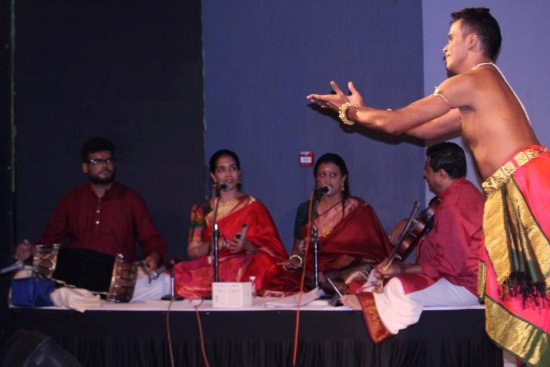 Anand Satchidanandan On 8th June 2024, Anand Satchidanandan, in an hour and half long Margam presentation, presented a kirtanam, "Sri Mahaganapati ravatummam" (Gowlai, mishra chapu), composed by Muthuswami Dikshitar, prefixed with a short mallari. The "balachandro" pose was very beautiful among other descriptions of the greatness of the Lord and the beautiful place, Thiruvarur, he resides in. Then he presented a short jathiswaram (Bilahari, adi) that is composed and choreographed by Anand and Jayalakshmi themselves. The song was perhaps so composed and dance so choreographed to present some adavu combinations with kanakku (read footwork) influenced by some Kathak tatkars. This was done aesthetically without giving up the Bharatanatyam feature of araimandi. He also took pivots while doing chinna theermanam. He followed it by a compact sabdam composed by Shemanar Koil Shanmugam, tuned by Turaiyur Rajagopala Sharma choreographed by his Gurus VP Dhananjayan and Shanta Dhananjayan on Lord Muruga. Here the devotee touches upon the Lord's various stages of growth and takes joy in remembering the Lord's attributes, a bhakti item with brevity and joy. A swarajathi (Chakravagam, adi) composed by Ponniah Pillai followed. The theermanams were done with great relish. Here the nayika requests the Lord to stay at her side for eternity. Finally she is happy with the sign (of a flower falling from his garland) given by Lord Brihadeeshwara that he is with her for eternity. The ashtapadi "Anilatharala" (Viswapriya, adi) tuned by Maharajapuram Santhanam, is a one sided story of a gopi in love with Krishna, again a virahotkandita. It was followed by Dakshinamurthy Ashtakam, (Ragamalika, adi) composed by Adi Shankara. The ashtakam is not simply a prayer but explains the philosophy of life (Advaita Vedanta). In these verses, Adi Shankara salutes Lord Dakshinamurthy as the Guru who makes us understand that "Consciousness" is the "Ultimate Truth". One who realizes this truth is an enlightened soul. The verses explain this philosophy with analogies. With apt gestures and expression, Anand communicated these verses to the audience. Music for this item was set to tune by Vidya Harikrishna. Anand gave a very erudite performance and captured hearts with his expressive face and charming smile. He was well supported by an excellent ensemble where his wife Jayalakshmi Anand on the nattuvangam, Vidya Harikrishna on the vocals, B. Anantharaman on violin and Prajesh Nair on mridangam serenaded the audience with their beautiful supportive music. 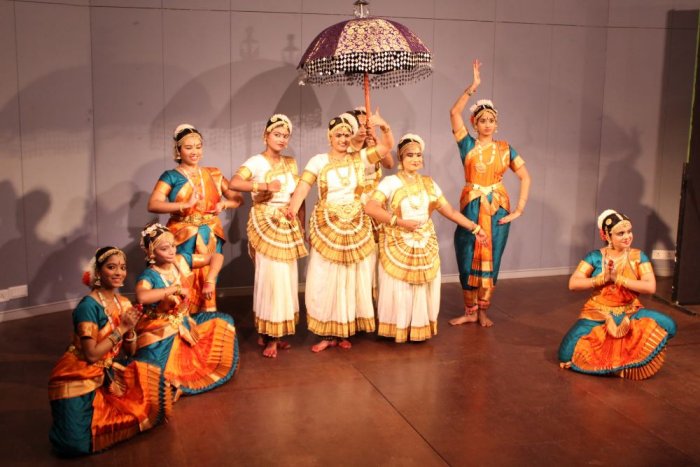 Navarasa Academy On 9th June 2024, PADAM presented a dance production by Navarasa Academy of Indian Classical Dance. It was presented by students of Guru Sushma Gopinath, in a jugalbandi of Bharatanatyam and Mohiniattam. Before presenting Dashavataram, they did items praying to Lord Ganesh "Sri Vighna rajam bhaje" (Gambhiranattai, kanda chapu) and Goddess Parvati "Pahi parvata nandini ma" (Arabhi, adi), in Bharatanatyam and Mohiniattam styles respectively, seeking their blessings to protect them. As a prelude to Dashavataram, they danced to songs like "Bharo Krishnaiyya" (Ragamalika, adi) in Bharatanatyam style and "Ajitha harey"(Mohiniattam style) describing antics of Krishna and in the other explaining that Krishna is the Ultimate God and has taken birth in the world to eliminate evil and establish peace on earth. Then with the song "Parkadal alai meley" (Ragamalika, adi) they brought stories of the ten avatars to life, interspersing the stories with jathis. All stories were briefly described and well performed. They held the rapt attention of the audience. Each story ended well with the characters posing like a fresco depicting the story. The presentation was calm and relaxing, and thoroughly enjoyed by the audience. 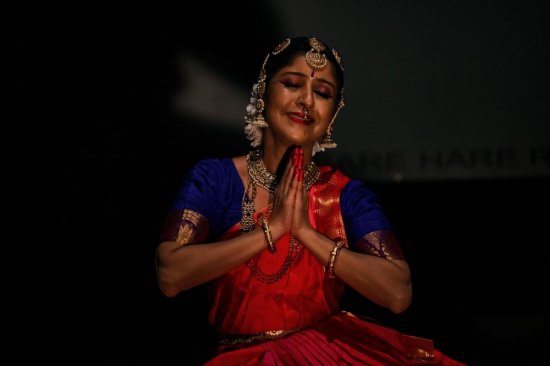 Sujatha Ramanathan Sujatha Ramanathan, a Bharatanatyam artiste, performed under the aegis of Ayyappa Seva Sangham, Bombay. The sangham holds Prathishta Dinam of the Ayyappa temple, Bangur Nagar, Goregaon every year with cultural programs and this endeavor has eventually evolved into holding a 12 day festival every year. It has been seen as a space that encourages the teachers of classical arts to present their students and an opportunity for upcoming artistes to motivate them in their endeavors of learning and pursuing classical art. They deem the program as offerings to the deities of Lord Ayyappa and Lord Guruvayurappa venerated at the temple. Now in the 41st annual Prathishta Dinam Utsavam 2024 celebrations, on 31st May (10th day of the utsavam), Sujatha offered her salutations to the Gods, through 'Krishnaarpanam,' a Krishna based concept. In the three items presented, each item had a different style of presentation. The first item was a traditional style of Bharatanatyam, a kirtanam by Muthuswami Dikshitar, "Sri Mahaganapati ravatumam" (Gowlai, misra chapu) choreographed by Guru Lata Raman - a tribute to Lord Ganapati as the remover of obstacles, as one who helps us cross the ocean of samsara and describing his grandeur as one who lives in the middle of the lotus lake at Thiruvarur. The second item performed, was a swarajathi in praise of Lord Vishnu, "E mayaladira" (Husseini, rupakam), a composition of Melattur Venkatarama Sastri in an expression of the "union of atma with paramatma". The choreography was by Ramya Ramnarayan. Even though the traditional structure of the swarajathi item was followed one could see a new approach to the korvais, jathis, theermanams and ardhis performed. There were many singlehanded adavus used in the korvais and jathis and at many places the chinna theermanams and periya theermanam were replaced by new cadences of movement. Also the ardhis done after the sangati was innovative. This totally brought a different dimension to the classical style of Bharatanayam. The third item presented was "Vrindavani Venu," an abhang by Bhanudas, set in Ragamalika. In this item, Sujatha has shown her leanings towards Bharata Nrityam using karanas to present the item; the music and choreography was by Dr. Sujata Mohan. The song is a beautiful ode to Lord Krishna praising his charm and the love and devotion of his followers. Here the poet speaks about how Krishna's mellifluous playing of the flute mesmerizes one and all. All forget the petty differences among them and get united, gathering at one place to hear his flute music. Sujatha has fantastic expressive abilities. Right from the first item, all feelings, whether bhakti or viraha, were expressed with aplomb. Each point of abhinaya presentation was well thought out. For the line "Bhumilo velayu" in the swarajathi, she briefly showed the Dashavatara stories, for the line 'achyuta vaaridi" Rukmini Kalyanam and for the sangati "Bhaktulaka"- Sudhama story. Each time she expressed why he did not give her a glance, has forgotten her, in a different way. All the nayika hoped was union with the nayaka, the compassionate Lord. The karanas presented to show the peacock, the tiger, deer and birds were perfect. Shoushtavam was held throughout the presentation. The artiste danced to recordings done by three different ensembles. It was an enthralling performance that the organisers immediately invited her to take part in the next upcoming festival in December 2024 too. 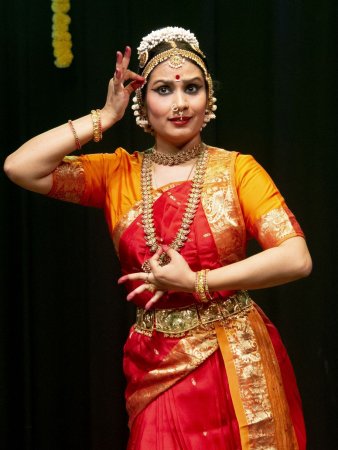 Maya G. Shivakumar On May 29, 2024, Maya G. Shivakumar presented a Bharatanatyam recital along with her students under the aegis of Mulund Bhajana Samaj for its 'Bhakti Bhajanotsavam 2024' event. The students performed to Maha Ganapathim (Naatai, chatusra ekam), a composition of Muthuswami Dikshitar extolling the virtues of Lord Ganapathi as a great admirer of literature, music and dramatics. He is praised by his parents and brother, and as the one who rides the mooshika for his vehicle and lover of the sweet modaka. Then the students performed Ranjani mala (Ragamalika, adi), a beautiful composition by Thanjavur Shankara Iyer. This song is four line versed, describing the Goddess and is interspersed with swaras. And the charming fact of this song is that each verse is set to music with ragas having same names as the Goddess has in the verse as Ranjani, Sriranjani, Megharanjani and Janaranjani. The korvais performed to the swaras were handled with grace and crispness. Maya performed the varnam (Karaharapriya, adi) composed by Tenmadam Narasimhachari. A piece dedicated to Lord Rama choreographed by Maya herself, she presented 4 episodes from Ramayana as sancharis. The killing of Vaali, the end of Kara and Dooshana, the meeting of Rama with Shabari, Bharata's request to Rama to return to the kingdom and Rama upholding his promise he made to his late father. Maya excelled in her portrayal of Shabari and other characters. And her jathis performed in this varnam were a choreographic marvel. The kirtanam "Yarendru Raghavanai" (Yadukula Kambhoji, adi) from 'Rama Nataka Kirtanams' of Arunachala Kavi saw Lakshmana praising Rama while describing his valor to Sita as he was trying to convince Sita, that the voice she heard was not Rama's. The students danced with confidence and Úlan to the sangatis which described the valorous Rama. Shiva Stuthi "Bho shambho" (Revati, adi) composed by Swami Dayanand Saraswathi glorifies Shiva as the Ultimate. The students showed Lord Shiva in all his splendor and taking valid poses according to the lyrics. In "Jagadodarana" (Kaapi, adi) composed by Purandaradasa, the approach of Maya, the choreographer, was totally new. She showed how the great God who was the savior of the devotees (Gajendara moksham was given as example) and the world, becomes the bundle of joy for his mother Yashoda. The different ways she showed Yashoda, who is unaware of his greatness treating him like a normal child, like feeding him, punishing him, pushing him away when he irritates her, was very endearing to see. And Krishna played with her, told her she was the best person around him and cries to her for attention. When he fought with the snake Kaalia, it caused Yashoda concern as she knew him only as her small child. The story of little Krishna showing the world within his mouth was performed with aplomb and finally the story from Mahabharata giving Arjuna the Vishwaroopa Darshan also was delineated. Maya was very expressive and this item held the rapt attention of the audience. 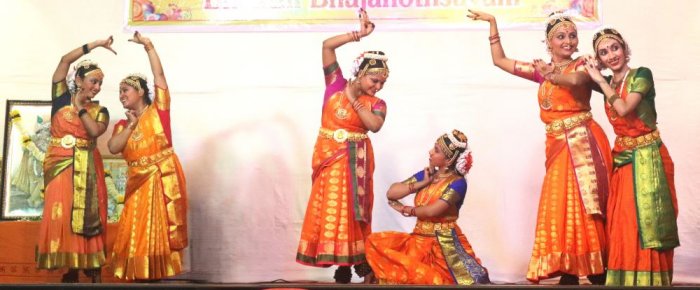 Raas Kreeda - Vanasri, Susmita, Pallavi, Priya, Pooja, Satvika Raas was a beautiful item about Krishna and the gopis. The audience was very engrossed seeing the delineation of Krishna playing mischief on the gopis; and how the gopis were mesmerized and left what they were doing to be near him to enjoy his music on his flute. And then raas leela was depicted which had an enchanting choreography. The lyrics for this item is from Krishnakarnamrutam slokams penned by Bilvamangalam, the great Kerala poet and tuned by Mumbai P.S. Krishnamurthy in ragam Brindavana Saranga and set to adi talam. The next item was a Marathi abhang, a composition of Sant Tukaram. "Bolava Vittala, pahava Vittala" describes the ecstatic state of mind of a devotee who wants to become one with Vittala. He wants to leave behind all the attachments of the world and cleanses his mind of all desires and anger. The item done with full bhakti, the audience was swayed by the presentation. The song was sung by the RaGa sisters - Ranjani and Gayatri. The Thillana (Sumanesaranjani, adi) was composed by Shatavadhani Ganesh. This item had diverse foot work and ended with a variety of poses taken by all artistes. The Mulund Bhajana Samaj was established in 1955 to imbibe the spirit of Sanathana Dharma through bhakti margam and spread and propagate the art of namasankeerthanam amongst the people of Mulund. It is one of the oldest organizations in Mulund which has been involved in the cultural activities through their Bhajanotsavam event for the past 15 years. In fact, their knowledge and enthusiasm for the art was clearly seen when immediately after the performance of Maya G. Shivakumar and her students they gave a short review of the items performed and encouraged and felicitated the artiste with garlands and shawls. The program was performed on recorded music, with Maya G. Shivakumar on nattuvangam, Chandana Bala Kalyan on vocals, Sathish Krishnamurthy on mridangam and Ravi Anantaraman on the violin. The Raas-leela music (also recorded) was handled by Mangala Vaidyanathan on violin, Saipriya Vishwanathan on veena, Satva Srinath on flute and Rajesh Srinivasan on mridangam. Maya was well supported by her students Vanasri Sridhar, Satvika Ramesh, Priya Suryavanshi, Pallavi Redkar, Pooja Bhalerao, and Susmita Bedge. 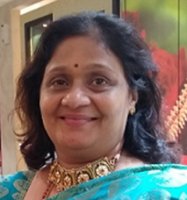 Chandra Anand is a Bharatanatyam artiste and teacher. She has an MA in Bharatanatyam from Tilak Maharashtra Vidyapeeth, and her series on 'Education in spiritual values through Bharatanatyam' is featured in narthaki.com. |